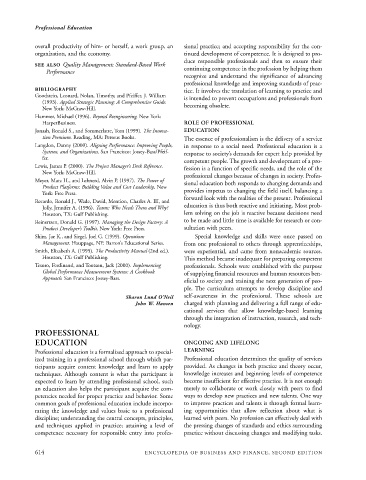Page 637 - Encyclopedia of Business and Finance
P. 637
eobf_P 7/5/06 3:18 PM Page 614
Professional Education
overall productivity of him- or herself, a work group, an sional practice; and accepting responsibility for the con-
organization, and the economy. tinued development of competence. It is designed to pro-
duce responsible professionals and then to ensure their
SEE ALSO Quality Management; Standard-Based Work
Performance continuing competence in the profession by helping them
recognize and understand the significance of advancing
professional knowledge and improving standards of prac-
BIBLIOGRAPHY tice. It involves the translation of learning to practice and
Goodstein, Leonard, Nolan, Timothy, and Pfeiffer, J. William is intended to prevent occupations and professionals from
(1993). Applied Strategic Planning: A Comprehensive Guide.
New York: McGraw-Hill. becoming obsolete.
Hammer, Michael (1996). Beyond Reengineering. New York:
HarperBusiness. ROLE OF PROFESSIONAL
Jonash, Ronald S., and Sommerlatte, Tom (1999). The Innova- EDUCATION
tion Premium. Reading, MA: Perseus Books. The essence of professionalism is the delivery of a service
Langdon, Danny (2000). Aligning Performance: Improving People, in response to a social need. Professional education is a
Systems, and Organizations. San Francisco: Jossey-Bass/Pfeif- response to society’s demands for expert help provided by
fer.
competent people. The growth and development of a pro-
Lewis, James P. (2000). The Project Manager’s Desk Reference. fession is a function of specific needs, and the role of the
New York: McGraw-Hill.
professional changes because of changes in society. Profes-
Meyer, Marc H., and Lehnerd, Alvin P. (1997). The Power of
sional education both responds to changing demands and
Product Platforms: Building Value and Cost Leadership. New
York: Free Press. provides impetus to changing the field itself, balancing a
forward look with the realities of the present. Professional
Recardo, Ronald J., Wade, David, Mention, Charles A. III, and
Jolly, Jennifer A. (1996). Teams: Who Needs Them and Why? education is thus both reactive and initiating. Most prob-
Houston, TX: Gulf Publishing. lem solving on the job is reactive because decisions need
Reinertsen, Donald G. (1997). Managing the Design Factory: A to be made and little time is available for research or con-
Product Developer’s Toolkit. New York: Free Press. sultation with peers.
Shim, Jae K., and Siegel, Joel G. (1999). Operations Special knowledge and skills were once passed on
Management. Hauppage, NY: Barron’s Educational Series. from one professional to others through apprenticeships,
Smith, Elizabeth A. (1995). The Productivity Manual (2nd ed.). were experiential, and came from nonacademic sources.
Houston, TX: Gulf Publishing. This method became inadequate for preparing competent
Tesoro, Ferdinand, and Tootson, Jack (2000). Implementing professionals. Schools were established with the purpose
Global Performance Measurement Systems: A Cookbook of supplying financial resources and human resources ben-
Approach. San Francisco: Jossey-Bass.
eficial to society and training the next generation of peo-
ple. The curriculum attempts to develop discipline and
Sharon Lund O’Neil self-awareness in the professional. These schools are
John W. Hansen charged with planning and delivering a full range of edu-
cational services that allow knowledge-based learning
through the integration of instruction, research, and tech-
nology.
PROFESSIONAL
EDUCATION ONGOING AND LIFELONG
Professional education is a formalized approach to special- LEARNING
ized training in a professional school through which par- Professional education determines the quality of services
ticipants acquire content knowledge and learn to apply provided. As changes in both practice and theory occur,
techniques. Although content is what the participant is knowledge increases and beginning levels of competence
expected to learn by attending professional school, such become insufficient for effective practice. It is not enough
an education also helps the participant acquire the com- merely to collaborate or work closely with peers to find
petencies needed for proper practice and behavior. Some ways to develop new practices and new talents. One way
common goals of professional education include incorpo- to improve practices and talents is through formal learn-
rating the knowledge and values basic to a professional ing opportunities that allow reflection about what is
discipline; understanding the central concepts, principles, learned with peers. No profession can effectively deal with
and techniques applied in practice; attaining a level of the pressing changes of standards and ethics surrounding
competence necessary for responsible entry into profes- practice without discussing changes and modifying tasks.
614 ENCYCLOPEDIA OF BUSINESS AND FINANCE, SECOND EDITION

